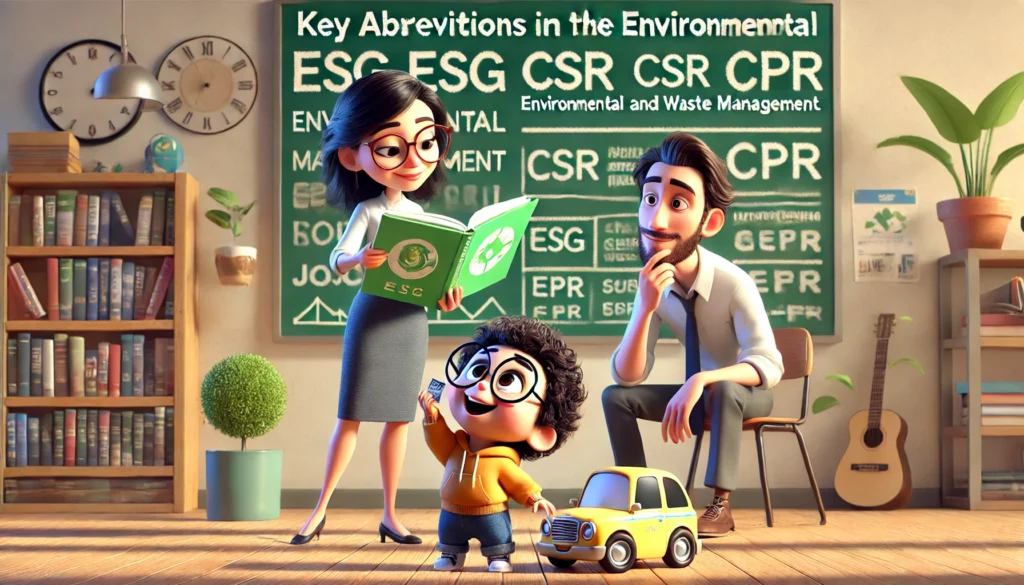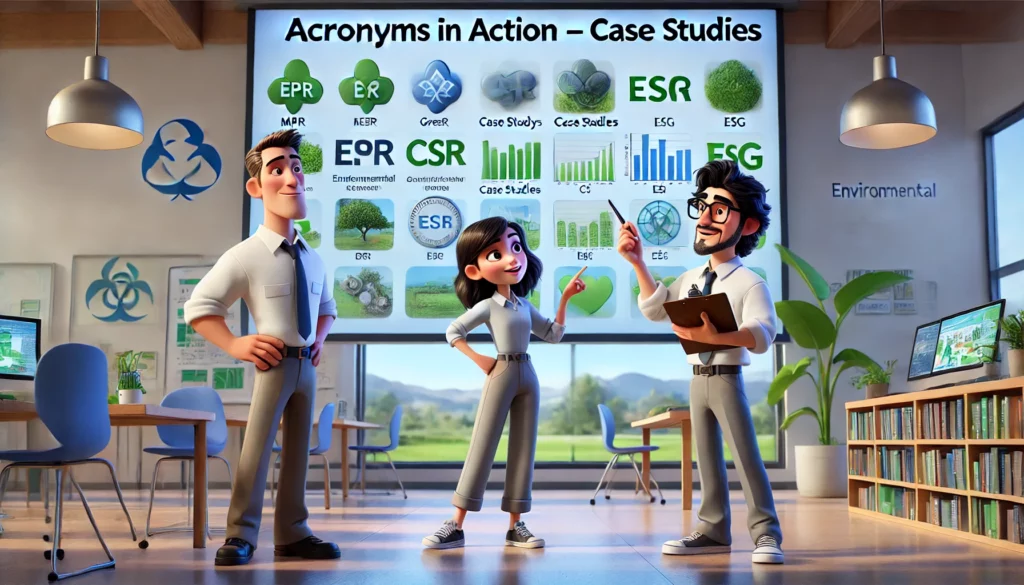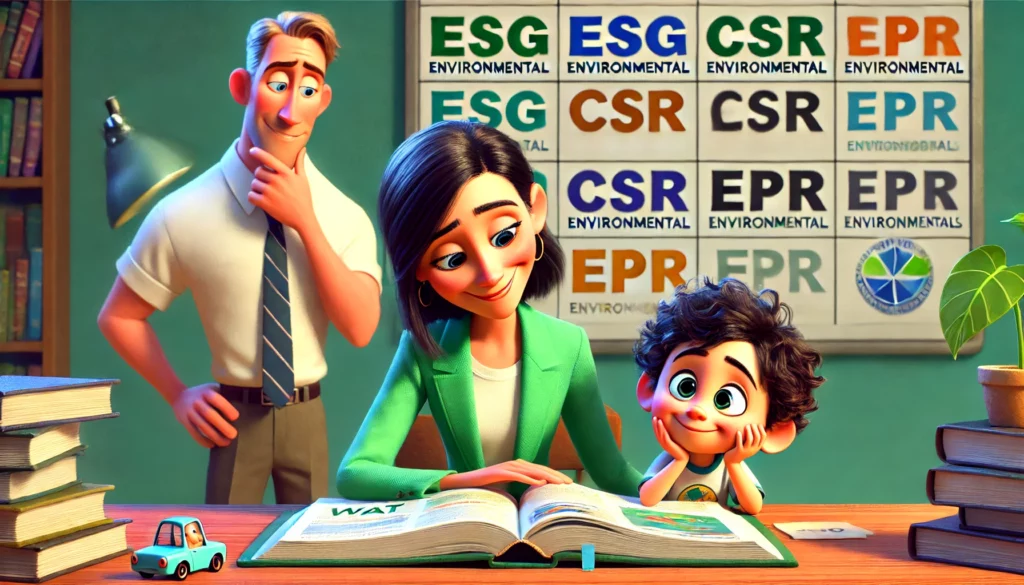The world of waste management and environmental sustainability is filled with a variety of acronyms, or abbreviations, that represent important policies, initiatives, and standards. These acronyms serve as shorthand for complex concepts and regulatory frameworks that govern how businesses and governments approach sustainability, corporate responsibility, and environmental stewardship.
Let’s explain some of the most commonly used acronyms in the waste, and environmental sectors and then dive into an in-depth comparison of ESG (Environmental, Social, and Governance), CSR (Corporate Social Responsibility), and Sustainability, helping you understand their differences and how they complement each other.

Section 1: Key Abbreviations in the Environmental and Waste Management World
1. EPR: Extended Producer Responsibility
EPR is a policy approach in which producers are given significant responsibility for the treatment or disposal of post-consumer products. It aims to reduce waste and promote recycling by making manufacturers accountable for the entire lifecycle of their products, especially at the end of their use. The goal is to encourage producers to design products with minimal environmental impact.
2. CSR: Corporate Social Responsibility
CSR refers to the responsibility that businesses have to contribute positively to society and the environment. It involves initiatives and practices that go beyond profit-making and include efforts to reduce carbon footprints, improve working conditions, support community development, and engage in ethical business practices.
3. ESG: Environmental, Social, and Governance
ESG refers to the three central factors used to measure the sustainability and societal impact of an investment in a company or business. These factors include:
- Environmental: The impact a company has on the environment, including resource use, waste management, and climate change mitigation.
- Social: How the company manages relationships with employees, suppliers, customers, and the communities where it operates.
- Governance: The internal systems that ensure the company complies with the law, maintains transparency, and acts ethically.
4. ISO: International Organization for Standardization
ISO provides international standards for various sectors, including environmental management. The most notable standard related to environmental management is ISO 14001, which sets the framework for companies to build an effective Environmental Management System (EMS).
5. SDGs: Sustainable Development Goals
SDGs are a collection of 17 global goals set by the United Nations to address global challenges such as poverty, inequality, environmental degradation, and climate change. Achieving these goals is considered crucial for securing a sustainable future by 2030.
6. LCA: Life Cycle Assessment
LCA is a methodology for assessing the environmental impact of products throughout their life cycle, from raw material extraction to disposal. This assessment helps businesses and regulators understand the full environmental costs of their products and identify areas for improvement.
7. GHG: Greenhouse Gas
GHG refers to gases that trap heat in the atmosphere, contributing to global warming. The most common greenhouse gases are carbon dioxide (CO₂), methane (CH₄), and nitrous oxide (N₂O). Reducing GHG emissions is central to combating climate change.
8. LEED: Leadership in Energy and Environmental Design
LEED is a certification program that recognizes best-in-class building strategies for sustainability. LEED-certified buildings are designed to be energy-efficient, reduce water consumption, and have a minimal environmental footprint.
9. COP: Conference of the Parties
COP refers to the annual meeting of all the countries that are part of the United Nations Framework Convention on Climate Change (UNFCCC). These conferences aim to review progress on climate change and set future goals. COP28 in 2023 was a major global event in Expo City, Dubai.
10. GWP: Global Warming Potential
GWP is a measure of how much heat a greenhouse gas traps in the atmosphere over a specific time period, relative to carbon dioxide. It helps policymakers compare the impact of different GHGs and prioritize reduction efforts.
11. CDP: Carbon Disclosure Project
CDP is a global disclosure system that enables companies, cities, and governments to measure and manage their environmental impacts. It is widely used by investors to assess the environmental performance of companies.
12. WEEE: Waste Electrical and Electronic Equipment
WEEE refers to discarded electrical and electronic products such as computers, televisions, and refrigerators. Managing WEEE involves reducing the environmental impact of electronic waste through recycling and proper disposal.
13. OEM: Original Equipment Manufacturer
OEM refers to a company that produces parts or equipment that may be marketed by another manufacturer. In the context of waste management and environmental sustainability, OEMs are often involved in designing products with sustainability in mind, such as making them easier to recycle or refurbish. OEMs may also have responsibilities under EPR (Extended Producer Responsibility) to ensure that their products are properly managed at the end of their lifecycle.
14. BAN: Basel Action Network
BAN refers to the Basel Action Network, a non-profit organization on a mission to champion global environmental health and justice by ending toxic trade, catalyzing a toxics-free future, and advocating for everyone’s right to a clean environment.
15. PCP: Post-Consumer Plastic
PCP refers to plastics that have been used by consumers and then collected for recycling. These plastics are processed and turned into recycled plastic materials for use in manufacturing new products. Post Consumer Plastics play a crucial role in reducing the environmental impact of plastic waste by promoting the circular economy, ensuring that plastics are recycled and reused instead of ending up in landfills or oceans.

Section 2: Comparing Key Concepts
With so many acronyms in the environmental and waste management space, it’s important to clarify how certain terms, like ESG, CSR, and Sustainability, relate to each other. While they are often used interchangeably, there are significant differences in their scope and purpose.
ESG vs. Sustainability
While both ESG and Sustainability focus on reducing a company’s negative impact on the environment, they differ in approach and audience.
- Sustainability: Refers to a broader concept that aims to meet the needs of the present without compromising the ability of future generations to meet their own needs. It encompasses environmental, social, and economic factors and is typically associated with long-term strategies to protect the planet and society.
- ESG: On the other hand, focuses on quantifiable metrics and is primarily used by investors and stakeholders to assess how well a company is managing risks related to environmental, social, and governance issues. ESG criteria can affect investment decisions and company valuations.
In essence, Sustainability is a broad and overarching goal, while ESG provides specific metrics for evaluating how companies are progressing toward that goal.
ESG vs. CSR
At first glance, ESG and CSR may seem synonymous since both relate to a company’s ethical responsibility. However, they diverge in significant ways.
- CSR: Is voluntary and often focuses on a company’s initiatives to give back to society, improve working conditions, and reduce environmental harm. CSR activities often include philanthropy, community engagement, and sustainable practices. The key point is that CSR is typically unregulated and driven by corporate goodwill.
- ESG: Takes this one step further by providing a measurable framework that holds companies accountable. ESG performance is monitored by investors, and poor ESG ratings can lead to financial consequences, making it a more rigorous and data-driven approach than CSR.
While CSR is about doing good, ESG is about being accountable for how your business impacts people and the planet—and how investors perceive your sustainability performance.
Sustainability vs. Impact
Sustainability and Impact are both terms frequently used when discussing the role of businesses in society, but they reflect different aspects of corporate behavior.
- Sustainability: As mentioned earlier, refers to efforts to reduce negative environmental, social, and economic impacts while promoting long-term ecological balance. It aims to create business models that can be sustained without depleting natural resources or harming the environment.
- Impact: Refers to the tangible effects that a company’s activities have on society and the environment. This can include both positive and negative impacts, such as creating jobs in disadvantaged communities or reducing carbon emissions. Impact Investing, for example, specifically focuses on investments made with the intention of generating measurable social and environmental benefits alongside financial returns.
The key difference is that Sustainability is about maintaining balance over time, while Impact is about the immediate outcomes of corporate actions.

Section 3: Acronyms in Action – Case Studies
To better understand how these acronyms play out in real-world scenarios, let’s take a look at a few examples.
Case Study 1: EPR in Action
In the European Union, Extended Producer Responsibility (EPR) has been widely adopted in the packaging industry. Companies are required to finance the recycling and disposal of their products once they reach the end of life. This has led to a significant increase in recycling rates for paper, plastics, and electronic waste (WEEE).
Case Study 2: CSR vs. ESG in Big Corporations
A well-known company such as Unilever implements both CSR and ESG. Under its CSR initiative, Unilever has supported community health and education projects globally. Meanwhile, Unilever’s ESG performance is evaluated by investors based on how well the company manages its environmental footprint, improves working conditions, and ensures good governance practices.
Case Study 3: Sustainability & Impact Investing
The Global Impact Investing Network (GIIN) is a leader in promoting investments that create both financial returns and positive environmental or social impacts. For example, impact investments might fund renewable energy projects that reduce carbon emissions while also delivering profits to investors. This is different from traditional investments, which may only focus on financial gains without considering the environmental or social consequences.
Bridging the Gap Between Terms
Navigating the maze of environmental and waste management acronyms can be challenging, but understanding them is critical to fostering meaningful change. ESG, CSR, Sustainability, and other related concepts all play vital roles in shaping how businesses and governments address environmental and social challenges.
By understanding the differences and relationships between these terms, companies can better communicate their efforts to stakeholders, investors, and customers, ensuring that everyone is aligned on the path to a more sustainable future.
